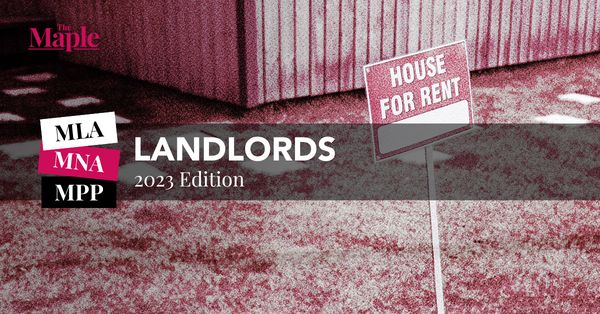On Monday, the Globe and Mail published an article about landlords that is both mundane and enraging — mundane because it hardly stands out amidst the recent wave of ‘pity the landlords’ articles, and enraging for the same reason. I’m fed up, so I’m going to complain about it here. Quoted bits from the article will be bolded.
The article is titled “Some new landlords are losing money. With rates rising, tenants could see rent hikes.” So, right off the bat you can tell you’re about to read some bullshit. The first sentence doesn’t disappoint: “As high as Toronto and Vancouver rents may seem to local tenants, landlords are often losing money on them.”
An April report from rentals.ca found that the average rent for a one-bedroom apartment in Toronto and Vancouver is $2,023 and $2,280 per month, respectively. According to another article by the Globe author, published in February, these rents would require annual incomes of more than $90,000 and $95,000, respectively. Meanwhile, average incomes in Toronto and Vancouver as of 2020 were $52,700 and $52,600, respectively.
Rents in Toronto and Vancouver don’t just seem high: they are high.
It gets worse: “In recent years, many mom-and-pop real estate investors in the two cities have been quietly paying more in mortgage and other ownership costs than they receive in rent, trusting they’d eventually sell at a profit thanks to rapidly rising home values, experts say.”
First of all, what’s a “mom-and-pop real estate investor”? The term comes up a couple times in the article, but is never given a clear definition, here or anywhere else. The notorious phrase was critiqued in a must-listen September 2021 Citations Needed episode, fittingly titled “How Real Estate-Curated ‘Mom & Pop Landlord’ Sob Stories Are Used to Gut Tenant Protections.”
Second, how “quietly” can these landlords be paying more in mortgage if we’re getting treated to articles in national newspapers about them doing so?
Third, the sentence establishes that investors went into these situations expecting to eventually cash out and being prepared to potentially lose money until then. I think that’s giving a bit too much credit to the average landlord’s planning abilities, but if we assume it’s accurate, then the only justification for a news article here would be home prices crashing. But are they?
In April 2022, according to listing.ca, the average sale price of a home in Toronto was $1,161,200, up $342,450 from the April 2020 average. Meanwhile, according to CTV News coverage of a report from the Real Estate Board of Greater Vancouver, “the benchmark price for all homes in Metro Vancouver at the end of 2021 was $1,230,200, which is a 17.3 per cent increase from December 2020. Prices for detached homes and townhouses rose 22 per cent last year. Apartment prices increased 12.8 per cent.”
So, in short, things are going as expected for landlords. What’s the problem?
“But as interest rates shoot up and price growth slows, some highly indebted landlords are beginning to feel the squeeze more acutely. That financial pain could eventually push rents even higher, some experts warn.”
The supposed problem, it turns out, is that the record-breaking value increases aren’t breaking enough records for landlords. And as for that next sentence? That’s where the problems with this article really begin.
The article accepts the framing from “experts” that landlords increase rents merely to help cover their costs. It doesn’t entertain the, to put it mildly, very real possibility that rent hikes are due to landlords wanting to profit by greater margins while they wait to make the major cash out. No, these rent hikes are supposedly inevitable and justified, and only done by benevolent landlords who are merely seeking to not lose a cent on their investment. And as for the “experts” giving these opinions? We have a Toronto-based mortgage broker, the president of a real estate company in Toronto and the director of content at a real estate marketplace.
In the description for the Citations Needed episode I mentioned earlier, they note that they “examine how the media-burnished image of the beleaguered, barely-scraping-by landlord puts a human face on policies that further enrich a property-owning class while justifying the forceful removal of renters from their homes.” This article does exactly that, even if the writer doesn’t intend for it to.
Now the article enters into many paragraphs describing the supposed bind landlords are in. The writer makes it clear this so-called problem exists for a specific sort of landlord, which they describe as “an investor who bought in the past 18 months at a much higher price using a HELOC for the down payment and with rent not fully covering [their] monthly costs.”
My heart goes out to the investor-who-bought-in-the-past-18 months-at-a-much-higher-price-using-a-HELOC-for-the-down-payment-and-with-rent-not-fully-covering-their-monthly-costs community.
The article then describes the exact series of boneheaded moves this well-off landlord-to-be would have to make to get themselves into a situation where they can’t afford to pay each month. But fear not, this is all part of the plan.
I’m going to quote from the next section of the article at length: “For many real estate investors, the main rationale for sinking hundreds of thousands of dollars into properties they won’t be able to rent out at a profit is the expectation of being able to sell at a much higher price. In the GTA, ‘people are investing based on the capital gains,’ Mr. Pasalis said. ‘They don’t mind if they’re cash flow negative each month because they assume the property’s going to be worth $50,000 or $70,000 more by the end of the year.’ […] Another group of investors ready to accept negative cash flow are those who buy properties as a future home for their kids, Mr. Tal said. Fear that the offspring will be permanently shut out of the real estate market is common in Vancouver, Ms. King said.”
So, this sob story is effectively about a small group of people complaining they aren’t making a profit while they wait to: a) make what is effectively a guaranteed mega-profit; or b) pass the property on to their kids so they can avoid the disastrous situation they’re complicit in creating? Here I have to quote Bernice Starnes, from a legendary 2016 interview: “I’m supposed to feel sorry for that bitch? I don’t!”
Now we get to a more disturbing part of the article, which, despite being more relevant to the average person in Canada than the preceding sections, is just a few paragraphs.
The article argues that the main beneficiaries of this supposedly worrying shift in the rental market will be … wait for it … other landlords: “While the resulting uptick in supply and slowdown in demand could put some downward pressure on prices, it could have the opposite effect on rents, according to Mr. Tal. That’s because a marginally smaller investor presence in the condo market will reduce the supply of units available for rent even as demand from tenants remains very strong.”
As per tenants? Well, they’ll suffer once again, not that the article ever focuses on their plight: “Larger mortgage payments could also increase landlords’ motivation to raise rents.”
But how exactly would this work? British Columbia currently has a rent increase cap of 1.5 per cent, while Ontario’s is (for most units, though not all) 1.2 per cent. Surely these increases couldn’t be enough to bail out the poor landlord?
Not to worry! One of the Globe’s interviewees has a solution in mind: “While rent-control regulation limits many landlords’ ability to ask for more from existing tenants, there are ways to work around the rules, he noted. For example, landlords often raise rents after a renovation that requires tenants to move out.”
Calling landlords “mom-and-pop real estate investors” was bad enough, but whitewashing landlords taking slimy (and sometimes illegal) actions to force people out of their homes is inexcusable. Want to know what some of the “ways to work around the rules” the Globe mentions look like in practice in Toronto?
There’s the renoviction method, whereby a landlord often will claim they’re planning renovations that require a tenant to leave, make very minor superficial changes and then increase the rent far above the guideline amount. They’re technically required to offer the unit back to the tenant, but at this point it’s almost guaranteed that they can’t afford it or have moved somewhere else. And voila, the landlord has just managed to circumvent rent control.
A Now Toronto article from 2018 describes such a situation, where a three-bedroom unit was renting for $2,500 per month. The three tenants were kicked out for renovations, mostly superficial changes were made and then the rent was jacked to $3,600 per month. That’s a 44-per-cent increase, in a year with a legal percentage increase of just 1.8 per cent.
Then there’s the “personal use” eviction method, whereby the landlord claims they, or someone in their family, needs to move into the unit. If the tenant doesn’t fight this eviction attempt, all the landlord has to do is provide them with a month of rent in compensation. Then they have the unit back in their hands, and can raise the rent as much as they’d like. Technically they’re required to live there for at least a year after the eviction, but this is difficult for tenants to monitor, and so landlords often get away with it.
And guess what?
These eviction methods haven’t been limited to the investor-who-bought-in-the-past-18 months-at-a-much-higher-price-using-a-HELOC-for-the-down-payment-and-with-rent-not-fully-covering-their-monthly-costs community. They haven’t been limited to landlords who are merely looking to balance out their costs (not that either situation would justify the tactics).
Instead, these tactics have become increasingly common in the past decade, as landlords seek to gorge on the incomes of renters to make ever-greater profits in a completely depraved rental market that a devastating pandemic only managed to bring a few months of relief to.
This is how corporate media operates: generate sympathy for the powerful, and ignore or disparage the rest of us.








Member discussion